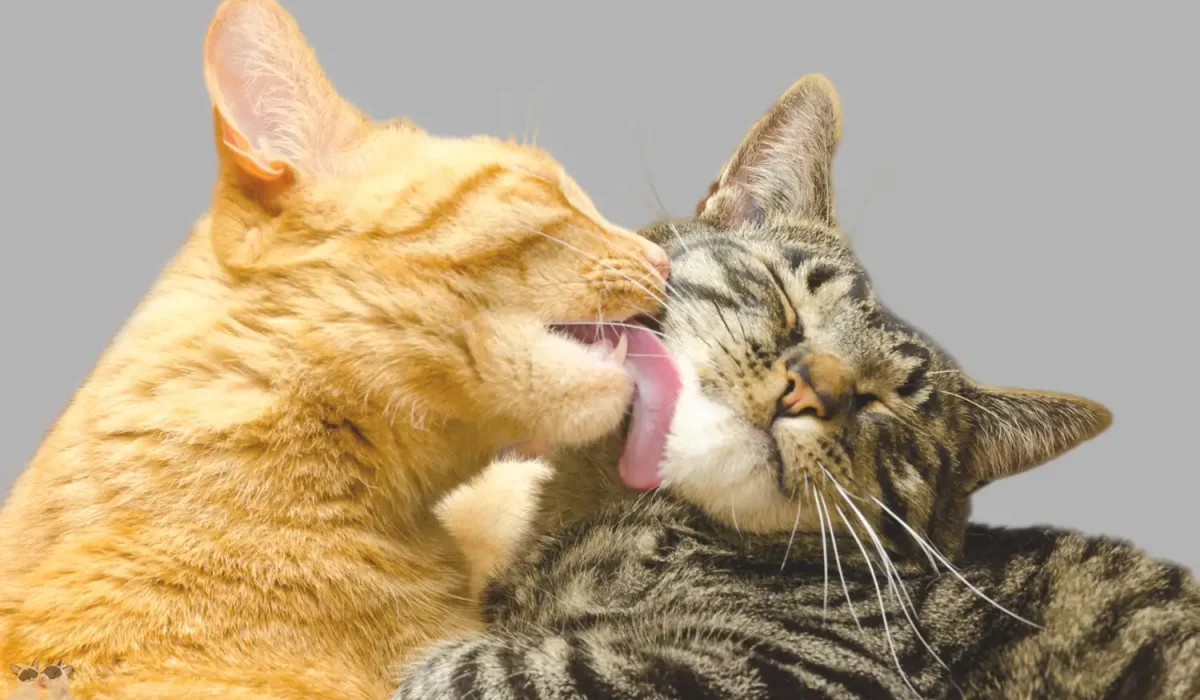Cats spend much time licking themselves, but sometimes, they lick other cats, too. This behavior, known as allogrooming, is a big part of how cats interact with each other. It’s more than just keeping clean—it helps them bond, communicate, and even decide social roles. This article will examine why cats groom each other and when owners should be concerned about too much licking.
Understanding Allogrooming in Cats
What is Allogrooming in Cats?
Allogrooming is when one cat licks or grooms another. It usually happens in areas that are hard to reach, like the head, ears, and neck. While self-grooming is mostly about hygiene, allogrooming is more about social bonding and showing trust.
Why Do Cats Groom Each Other?
Cats groom each other for many reasons. While cleanliness is one part of it, grooming is also a way for cats to strengthen their relationships and show affection. It is common among littermates, mother cats and their kittens, and cats that live together peacefully.
The Main Reasons Cats Groom Each Other
Social Bonding and Strengthening Relationships
One of the biggest reasons cats lick each other is to form and maintain strong friendships. Mutual grooming helps them feel close and connected, similar to how people show affection through hugs or handshakes.
Cleanliness and Hygiene Maintenance
Even though cats are great at cleaning themselves, they can’t always reach every spot. Grooming each other helps remove dirt, loose fur, and parasites from tricky areas like the head and ears.
Communication Through Grooming
Grooming is a quiet way for cats to communicate. It can be a way to show care and comfort, especially in a multi-cat home. When a cat licks another, it can mean, “I trust you” or “You’re part of my family.”
Grooming as a Form of Stress Relief
People might listen to music or take deep breaths when stressed, but cats use grooming to relax. Licking another cat can help both the groomer and the one being groomed feel calmer, especially during changes like moving to a new home or meeting a new pet.
Additional Reasons for Cat Grooming
Establishing Hierarchy and Showing Dominance
Sometimes, grooming isn’t just about affection but also social rank. In homes with more than one cat, the more dominant cat might groom the other to show leadership. This is usually gentle, but if one cat forces another into grooming, it might be a sign of control rather than care.
Mother and Kitten Bonding
Mother cats lick their kittens from birth. This keeps them clean, helps digestion, and creates a strong mother-kitten bond. It also teaches kittens how to groom themselves as they grow.
Grooming as a Sign of Acceptance
Cats that live together but do not groom each other may not be entirely comfortable with one another yet. When a cat allows another to groom it, it shows trust and acceptance in their shared space.
Providing Cleaning Assistance to Other Cats
Older cats or those with mobility issues may struggle to keep themselves clean. In these cases, younger or more flexible cats may help groom, ensuring their companion stays clean and comfortable.
Is It Normal for Cats to Groom Each Other?
When Grooming is a Sign of a Healthy Relationship
Whether your cats groom each other regularly and seem happy signifies a strong bond. Cats that lick each other and then cuddle or nap together show their trust. As long as the grooming isn’t rough or one-sided, it’s a healthy habit.
When Excessive Grooming Might Be a Concern
While allogrooming is usually good, too much licking can be a problem. Watch out for these signs:
- One cat licks the other so much that it causes bald spots or skin irritation.
- Grooming turns into rough play or aggression.
- A cat that used to groom a lot suddenly stops. If you see any of these signs, it’s a good idea to check with a vet to ensure there aren’t any underlying health or stress issues.
Frequently Asked Questions
Why do some cats groom each other and others don’t?
Not all cats groom each other. Some prefer to keep their personal space, while others might not have learned social grooming as kittens. Some cats show affection differently, like rubbing against each other or playing together.
Should I be concerned if my cats never groom each other?
Not necessarily. Some cats don’t engage in social grooming, but that doesn’t mean they don’t get along. As long as your cats coexist peacefully, there’s no need to worry.
Can excessive grooming lead to problems?
Yes, if one cat licks another too much, it can cause hair loss, skin irritation, or infections. If you notice excessive licking, it could be a sign of anxiety, dominance behavior, or an underlying medical issue that needs attention.
Conclusion:
Cats licking each other is more than cleaning—it’s about friendship, trust, and social order. Whether they do it to show love, relieve stress, or establish their place in the group, grooming is an important part of feline behavior. By understanding why cats groom each other, pet owners can better care for their furry companions and ensure a peaceful home environment.

